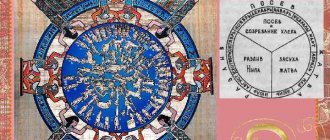Faith accompanies a person from birth to the end of the cycle of existence. All major wars are the result of clashes of religious preferences. The article contains brief descriptions of the ten most ancient religions on Earth.
Zoroastrianism is the most ancient religion on Earth (point No. 3)
Buddhism
Buddhism is the most ancient, world religion on earth. Originated in Ancient India in the 6th millennium BC. e. The origin is due to Siddhartha Gautama, the son of a royal person. The heir decided to leave the palace and saw that the world around him was mired in suffering and poverty. Struck by the surrounding reality, Siddhartha adopted an ascetic lifestyle and went to live with the monks. Through spiritual rebirth he became Buddha.
The religious system recognizes human suffering as a result of the desire for pleasure and the inability to get what they want. Giving up desires is promoted as the path to salvation.
Buddhism promotes rebirth, so a person should not sin in earthly life, so as not to become a being neglected by society in the next world.
Which religion is recognized as the most ancient?
When determining the most ancient faith, several facts must be taken into account. There are some religions, mentions of which remain only in old traditions and legends. Among these are the religions of the Incas and Aztecs. This is a developed religion with many followers in its ranks. The Inca faith is rich in the variety of gods. This is due to the military activities of the tribes. When new peoples were captured, deities from the traditions and legends of captives were added to the existing religion. Thanks to the possibility of the emergence of new deities, this belief did not disappear without a trace, but was simply transformed into new trends.
Of those currently existing, one of the first was the religion of the Sumerians. It was distinguished by many gods, each of which had its own followers, called the Anunnaki. They were priests who helped ordinary people communicate with their idols and conveyed the wishes of the gods to the people.
The oldest of the world's religions is Judaism, which was born from the teachings of Vedism. It is based on a religion that later laid the foundation for Christianity. But the imperfection of the existing gods and the many contradictory statements of this religion caused it to become one of the shortest.
Zoroastrianism
Zoroastrianism is the oldest , ancient Aryan religion of the 7th century BC. e., inherited by the Iranians. It arose on the basis of the worship of nature, justice and wisdom, which is why the dominant gods were Deva, Ahura and Mazda. Of all the elements, fire had leadership; with its help sacrifices were made.
According to the Avesta version, the god of wisdom prevails over the others, and the prophet Zuratushutra is endowed with inhuman capabilities. Following the precepts is the basis of Zoroastrianism.
Which religion was one of the last to appear?
The concept of “young” is very relative, because when counting over millennia, several centuries does not matter much. That is why the earliest faith, “Islam,” seems to us to have been known and widespread for a long time.
The basis of belief is service to Allah; a Muslim places the teachings of God above his own desires. Nowadays, Islam is quite popular; Muslims live in 50 countries around the world. Almost a quarter of the world's population is Muslim. This religion appeared in the seventh century AD, when the prophet Mohammed received the first verses of the Koran. The widespread teaching is more than thirteen centuries old, but younger religions of our time are not known.
The popularity of this belief is due to its strict rules and righteous lifestyle. Many children are born into Muslim families, which is why there are more and more adherents of Islam. The mullah serves as a means of communication between God and man. He conducts rituals and reads prayers, be it nikah, verse or other ceremonies.
The hypotheses are endless.
The origin and development of religion is a relatively new area of knowledge. For centuries, people have more or less accepted the religious traditions familiar from childhood. Usually they were content with the stories of their fathers and grandfathers, who considered their religion to be an immutable truth. It never occurred to people to doubt anything or try to find out how, when and why this or that custom arose. Due to limited freedom of movement and a narrow social circle, not many people even knew that there were any other religions on earth.
However, in the 19th century the situation began to change. The theory of evolution has captured the minds of the intelligentsia. With the advent of the era of scientific discoveries, people began to question everything, including religion. Some scientists have come to the conclusion that by studying modern religions, one still cannot get to the bottom of their origins. Therefore, they switched to studying the monuments of ancient civilizations or went to remote corners of the world where people still lived in primitive communities. Armed with the methodologies of various scientific disciplines - psychology, sociology, anthropology - they began to attack the questions of how religion arose and why.
What did this lead to? Scientists came up with a whole series of discordant theories, competing with each other in the boldness and extravagance of their conclusions. Moreover, there were, perhaps, no fewer theories than there were researchers themselves. Some have derived valuable propositions; the efforts of others have faded into oblivion. A brief overview of their research will be educational and will help to better understand the religious views of our contemporaries.
The English anthropologist Edward Tylor (1832-1917) put forward the so-called theory of animism. He suggested that dreams, visions, hallucinations and the lifelessness of dead bodies led primitive people to the conclusion that a soul (Latin anima) lived in their body. Since they often dreamed of deceased relatives, they, according to this theory, thought that the soul continues to live after death: it leaves the body and moves into trees, rocks, streams and the like. As a result, people began to deify the dead and those objects into which, in their opinion, souls moved. This is how religion came into being, according to Tylor.
Another English anthropologist, Robert Marett (1866-1943), modified Tylor's theory and proposed his own version, which became known as the theory of animatism. Having studied the beliefs of the Melanesians living on the Pacific Islands and the indigenous populations of Africa and America, Marett came to the conclusion that primitive people had no concept of the human soul. They rather believed in some impersonal or supernatural force that animates everything. Such faith aroused in man a feeling of awe and fear, which became the basis of his primitive religion. According to Marett, religion appeared primarily as a person’s emotional reaction to the unknown. Marett liked to say that religion “is not so much invented as danced.”
In 1890, Scottish ethnographer-folklorist James Fraser (1854-1941) published his famous book The Golden Bough, in which he stated that religion owes its origin to magic. According to Fraser, in the beginning, man tried to influence his life and the world around him by imitating what he saw in nature. For example, a person thought that if he sprinkled water on the ground while drums were roaring (imitating a thunderstorm), he could make it rain, and if he pricked the image of his enemy with thorns, he could be damaged. This is how rituals, spells and magical objects became widespread. When they did not act, man, instead of subjugating higher powers, tried to come to an amicable agreement with them and cajoled them in every possible way. Spells and rituals were transformed into prayers and sacrifices - and thus religion arose. Fraser himself explained: “By religion I mean the propitiation and pacification of powers higher than man.”
Even the famous Austrian psychoanalyst Sigmund Freud (1856-1939) tried to explain the origin of religion in his book “Totem and Taboo”. True to his craft, Freud argued that religion emerged from the so-called father complex. In his opinion, just as in herds of wild horses and bulls, in the human “primitive horde” the leader was the father. His sons both hated him and admired him. To seize the father's power, Freud said, these savages "joined together, killed and ate the father." However, later remorse forced them to come up with various rituals and ceremonies to atone for their guilt. According to Freudian theory, the father figure became God, rites and ceremonies became the primary religion, and eating the murdered father became a communion tradition practiced by many religions.
These, of course, are not all the theories that have been used to explain the origin of religion. Many of them were forgotten forever. But even those that remain cannot be called indisputable and reliably substantiated. They were simply not confirmed by any historical facts or evidence. They were just a figment of the researchers’ imagination, hypotheses that quickly replaced one another.
Islam arose at the beginning of the 7th century in Western Arabia, in Mecca
Islam translated from Arabic means “submission”, “surrender to [the One] God.” This is the youngest and second largest number of adherents, after Christianity, the world monotheistic Abrahamic religion. The number of adherents is more than 1.8 billion people living in more than 125 countries.
In 28 countries, Islam is the state or official religion. The majority of Muslims (85-90%) are Sunnis, the rest are Shiites and Badis. The preacher of Islam is the prophet Muhammad (571 - 632). The holy book is the Koran.
28
in so many countries of the world Islam is the state religion
The second most important source of Islamic doctrine and law is the Sunna, which is a set of traditions (hadith) about the sayings and deeds of the Prophet Muhammad. The language of worship is Arabic. Followers of Islam are called Muslims.
Al-Masjid an-Nabawi Mosque, Saudi Arabia. Here is the tomb of the prophet Muhammad. Prophet Muhammad is the founder of Islam. Photo: upload.wikimedia.org
Islam arose at the beginning of the 7th century in Western Arabia, in Mecca, where paganism reigned. Muhammad was one of the active Meccan Hanifs. The founder of Islam was born into the Qurshait tribe, was a shepherd, and was engaged in caravan trade.
In 610, at the age of 40, he declared himself a messenger (rasul) and prophet (nabi) of the one God (Allah) and began preaching a new monotheistic religion in Mecca, which he called Islam. In his sermons, Muhammad called for faith in one God, spoke about the brotherhood of believers and adherence to simple moral standards.
The prophet's calls did not meet with understanding and sympathy among the nobility of Mecca, who treated him with hostility. In 622, Muhammad, along with a few followers, fled from persecution by polytheists from Mecca to Medina.
Islam arose at the beginning of the 7th century, its founder was the Prophet Muhammad.
In Medina, Muhammad rallied the Arab population of the city around himself and created the first Muslim community (ummah). After the Muslim conquest of Mecca in 630, Islam became a pan-Arab religion, and Mecca became the center of Islam.
After the death of Muhammad, a theocratic state was formed - the Caliphate. The fullness of secular and spiritual power was concentrated in the hands of the caliphs. The first caliphs were Abu Bakr, Umar, Uthman and Ali. After them, the Caliphate was ruled by the Umayyad dynasty (661 - 750) and Abbasids (750 - 1258).
The wars of conquest waged by the first Islamic state in the 7th-8th centuries led to the spread of Islam in the countries of Western and Central Asia, North Africa, parts of India and Transcaucasia. Islam also penetrated into the Balkan Peninsula through Turkey.
Al-Haram Mosque and Mecca in the 20th century. Mecca is the center of Islam. Photo: upload.wikimedia.org
Islamic theology says that the first Muslims on earth were the first people Adam and Hawa (Eve). Islamic prophets include Nuh (Noah), Ibrahim (Abraham), Davud (David), Musa (Moses), Isa (Jesus) and others.
That is why in Islam it is believed that the prophet Muhammad was not the founder of Islam, but only the last prophet (“Seal of the Prophets”) who restored the true faith.
Muslims call Jews and Christians "people of the Book." Biblical stories about the prophets, about the creation of the world and man, about the global flood, etc., are reflected in a slightly transformed form in the Koran.
Taoism
Taoism (in simplified and traditional Chinese: literally "way teaching") is a philosophical and religious tradition of Chinese origin that emphasizes living in harmony with the Tao (in simplified and traditional Chinese: "the way", also referred to as harm). The Chinese word "tao" (or "dao", depending on the romanization used) is usually translated as "way", although it has countless nuances in popular Chinese philosophy and religions.
The Tao is a fundamental idea in most of the schools that are part of Chinese philosophy; however, for Taoism it is referred to as the principle of absolute unity and at the same time variability, which forms the ultimate reality and the cosmogonic and ontological principle of all things. Thus, for Taoists, the Tao constitutes the Source, structure and essence of all that exists.
The Tao Te Ching, also known as the Tao Te King or Tao Te Ching, is a book that summarizes the teachings attributed to the philosopher Lao Tzu (also called Lao Tzu, Lao Tzu, Laozi (in simplified and traditional Chinese: literally " old master") or Laosio. Although the historical existence of such a figure is still debated, the book is considered the key to the Taoist tradition.
Shamanism
It is impossible to consider primitive religions without highlighting the clergy. This is most acutely visible in shamanism. As an independent religion, it appears much later than those discussed above, and represents the belief that an intermediary (shaman) can communicate with spirits. Sometimes these spirits were evil, but most often they were kind, giving advice. Shamans often became leaders of tribes or communities, because people understood that they were associated with supernatural forces. Therefore, if something happens, they will be able to protect them better than some king or khan, who is only capable of natural movements (weapons, troops, and so on).
Elements of shamanism are present in virtually all modern religions. Believers have a special attitude towards priests, mullahs or other clergy, believing that they are under the direct influence of higher powers.
Animism
Primitive religions could not do without the participation of the human soul. Ancient people thought about such concepts as death, sleep, experience, and so on. As a result of such thoughts, the belief arose that everyone has a soul. Later it was supplemented by the fact that only bodies die. The soul passes into another shell or exists independently in a separate other world. This is how animism appears, which is a belief in spirits, and it does not matter whether they belong to a person, an animal or a plant.
The peculiarity of this religion was that the soul could live indefinitely. After the body died, it broke out and calmly continued its existence, only in a different form.
Animism is also the ancestor of most modern religions. Ideas about immortal souls, gods and demons - all this is its basis. But animism also exists separately, in spiritualism, belief in ghosts, essences, and so on.
Totemism
The types of religions of primitive man and their description should begin with totemism. Ancient people lived in groups. Most often these were families or their association. Alone, a person would not be able to provide himself with everything he needs. This is how the cult of animal worship appeared. Societies hunted animals to obtain food without which they could not survive. And the emergence of totemism is quite logical. This is how humanity paid tribute to its livelihood.
So, totemism is the belief that one family has a blood relationship with a particular animal or natural phenomenon. People saw them as patrons who helped, punished if necessary, resolved conflicts, and so on.
There are two features of totemism. Firstly, each member of the tribe had a desire to look like their animal. For example, some Africans knocked out their lower teeth to look like a zebra or antelope. Secondly, the totem animal could not be eaten unless the ritual was followed.
The modern descendant of totemism is Hinduism. Here some animals, most often the cow, are sacred.
Today there are 450 - 500 million Buddhists living in the world
As of 2010, the number of Buddhists was estimated at 450 - 500 million people. According to one estimate, 360 million Buddhists are Mahayana, 150 million Theravada, and about 18 million Tibetan Buddhism.
7 million
so many Buddhists live outside of Asia
At the same time, the number of Buddhists living outside Asia is estimated at 7 million people. The number of monks among all Buddhists is about 1 million.
The main number of Buddhists live in the countries of South, Southeast and East Asia: Bhutan, Vietnam, India, Cambodia, China (as well as the Chinese population of Singapore and Malaysia), Korea, Laos, Mongolia, Myanmar, Nepal, Thailand, Tibet, Sri Lanka Lanka, Japan.
Ulan-Ude datsan "Khambyn Khuree". In Russia, Buddhism is widespread in Buryatia, Kalmykia and Tyva. Photo: upload.wikimedia.org
Buddhism in Russia is traditionally practiced by residents of Buryatia, Kalmykia, and Tuva.
In recent years, Buddhist communities have emerged in Moscow, St. Petersburg, Samara and some other major Russian cities not associated with traditional Buddhist regions.
1%
this is how many adherents of Buddhism live in Russia
The number of Buddhists in these cities, according to surveys, is about 1% of their residents.
The same percentage is the number of Buddhists throughout the country. This is due to the fact that in the 20th century Buddhism began to spread throughout the world, leaving its natural boundaries.









